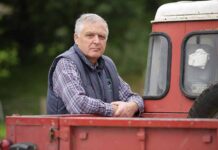Have you heard any strange snoring sounds at night?
According to Ulster Wildlife, it could be the sound of barn owl chicks, and the conservation charity is urging the public to get in touch, so it can help track down nest sites of this endangered bird.
“At this time of year, hungry barn owl chicks are calling to their parents for food, a rasping sound often referred to as snoring,” says Catherine Fegan, Barn Owl Officer with Ulster Wildlife.

“This call is exclusively associated with a nest site, and can be faint, but gets ever louder as the chicks grow and venture out of their nest. If you do hear ‘snoring’ or screeching sounds as you lie at night with your windows open it could indicate that a nest is nearby and we’d love to hear about it.”
With less than 30 to 50 breeding pairs of barn owls in Northern Ireland and only three known nest sites, Ulster Wildlife is working with farmers and landowners to ensure barns owls have suitable space to hunt and places to nest, thanks to support from Heritage Lottery Fund.
One such farmer Michael Calvert, of Barnwell Farm on the Ards Peninsula, erected a nest box seven years ago close to his rough grass margins – ideal hunting habitat for the birds. Last year, two chicks were born in the nest box – a first for Northern Ireland – and this summer his conservation efforts were rewarded with another two healthy owlets, which were ringed to help better understand these elusive birds.
Catherine added: “We know there must be more nest sites like Michael’s out there, but as barn owls range far in search of food, sightings of adult birds can be up to eight kilometres away from the nest. The unmistakeable ‘snoring’ from chicks at this time of year is the best hope we have of finding one and giving this threatened bird a fighting chance.”
Throughout August, teams of volunteer fieldworkers from Ulster Wildlife will be scouring the countryside for sights and signs of nest sites to help target conservation efforts, so any strong leads reported by the public will be followed up.
To hear barn owl chicks snoring at Barnwell Farm visit
www.ulsterwildlife.org/barnowl
Facebook @BarnwellFarmCottages
To report any strange snoring sounds or sightings of barn owls, contact Catherine Fegan, Barn Owl Officer at Ulster Wildlife on 028 9046 3112 or email:
catherine.fegan@ulsterwildlife.org
Barn Owl Facts
* The barn owl is a Red List species in Ireland.
* The barn owl is nocturnal and hunts mainly at dawn and dusk.
* Its favoured hunting habitat is rough, ungrazed grassland.
* It is silent in flight, but is often referred to as the ‘screech owl’ due to the ear-splitting sound it can emit.
* Its efficiency in eating small mammals, such as mice and shrews, has earned it the nickname ‘the farmer’s friend.’
* It is illegal to look in barn owl nest boxes without a special licence.
* Barn owls don’t make nests. They nest in old buildings, hollow tree trunks or occasionally nest boxes.
* Pairs will use the same location to breed every year.
* Egg laying starts between early March and mid September.
* Each pair will have 1 or 2 broods a year of between 4 to 6 eggs
* Incubation time is around 32 days
* Chicks fledge after 53-61 days
Michael Calvert won the RSPB Nature of Farming Award in 2009. He farms extensively, limiting insecticides and herbicides and grows spring crops to allow birds and small mammals to take advantage of the seed available in winter stubbles. As part of his former Countryside Management Scheme (CMS) he has hedgerow & rough grass margin habitats; the rough grass margin is perfect foraging habitat for barn owls.
www.ulsterwildlife.org
Ulster Wildlife is part of The Wildlife Trusts – a partnership of 47 covering the whole of the UK. Ulster Wildlife Trust is a local charity that champions native wildlife in Northern Ireland.
They work with local people to secure space for nature in our countryside, towns, coastlines and seas. Through the twin visions of Living Landscapes and Living Seas they work to inspire people to champion nature; protect and restore habitats through practical action and research; stand up for nature by influencing government policy; and promote health and well-being through enjoyment of the natural environment. They have approximately 12,000 members in Northern Ireland who provide vital support for their work.

























